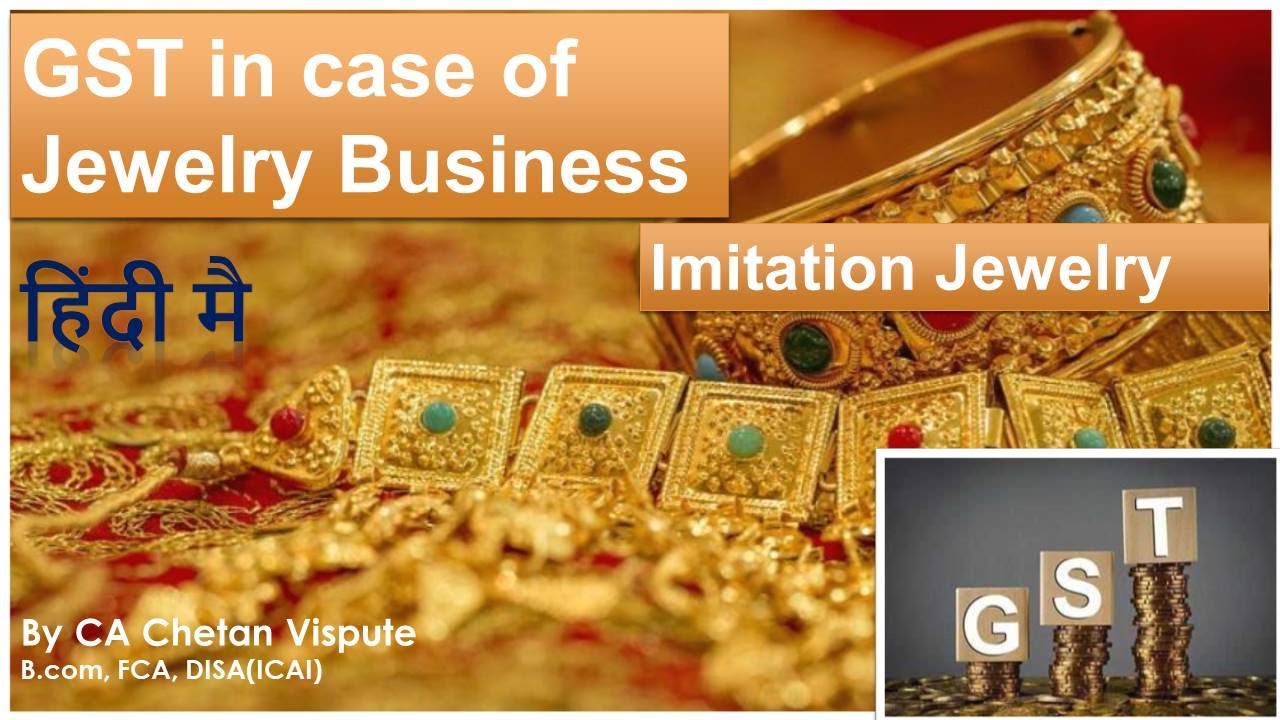Jewellery GST Rate Impact on Gold Ornaments in India
- 16 Aug 24
- 17 mins

Jewellery GST Rate Impact on Gold Ornaments in India
Key Takeaways
- Uniform GST Rate Enhances Transparency: The uniform 3% GST rate on gold has simplified taxation, making gold prices more predictable across India.
- Initial Price Increase Stabilized Over Time: Although GST initially raised gold prices, the market has since stabilized, benefiting consumers and traders with clearer pricing.
- Input Tax Credits Boost Business Efficiency: GST allows businesses dealing in gold to claim input tax credits, reducing the overall tax burden and enhancing operational efficiencies.
- Improved Regulatory Compliance: The streamlined GST framework has simplified compliance, reducing discrepancies and potential tax evasion in the gold trade.
- E-Way Bills Secure Gold Transportation: The mandatory E-Way Bill for transporting high-value gold ensures secure and compliant movement across state lines.
Gold, a cherished asset in India, has seen its tax structure reshaped with the introduction of the Goods and Services Tax (GST). This article explains various aspects of GST as applied to gold, including rates, calculation methods, and its overall impact on both consumers and the jewellery industry.
What is GST on Gold?
GST (Goods and Services Tax) on gold refers to the tax imposed on the purchase and manufacturing of gold-related and gold products in India. Introduced in 2017, GST is a unified indirect tax that has replaced multiple taxes such as VAT (Value Added Tax), excise duty, and others, streamlining the tax slab system.
GST Rates on Gold Purchase
The GST (Goods and Services Tax) rate on all forms of gold purchases in India is set at 3% such as gold bars, gold biscuits, gold coins, digital gold, gold ornaments, etc. This tax applies specifically to the value of the gold in any transaction, whether it's in the form of bars, coins, or jewellery. However, it's important to note that this rate does not include the making charges or additional costs associated with manufacturing the jewellery.
Making charges are taxed separately under GST at a rate of 5%. This means that when purchasing gold jewellery, the consumer pays a 3% GST on the gold content and an additional 5% GST on the labour charges involved in creating the jewellery. This two-tier tax structure was established to ensure both the raw material and craftsmanship are appropriately taxed, aiming to streamline taxation and increase transparency in the gold market.
GST on gold-making charges

In India, the Goods and Services Tax (GST) on making charges for gold jewellery is levied at a rate of 5%. Making charges are the fees associated with the craftsmanship involved in designing and crafting gold jewellery. This tax is separate from the GST applied to the raw gold itself, which is taxed at a rate of 3%.
Impact on Pricing:
The 5% GST on making charges is calculated based on the labour cost stated in the invoice. This separate charge is in addition to the GST on the gold content, affecting the total cost of gold jewellery. For instance, if the making charges are ₹10,000, a GST of ₹500 (5% of ₹10,000) will be added just for these charges.
How It Affects Consumers:
The application of GST on making charges means that consumers pay a higher overall price for gold jewellery. This is because the final price includes GST on both the gold value and the labour involved, thereby increasing the total cost of purchasing jewellery.
This distinction in taxing the raw material and the labour separately under the GST regime helps bring transparency to the pricing structures of jewellery, ensuring that taxes are levied both on the value of the material and the artisanship.
How to Calculate GST on Gold Jewellery
Calculating GST on gold jewellery involves a clear understanding of both the value of the gold and the associated making charges. Here is a step-by-step guide to help you determine the total GST payable when purchasing gold jewellery:
Step-by-Step Guide to Calculating GST on Gold Jewellery
Step 1: Determine the Market Value of the Gold
Start by finding out the current market value of the gold you are purchasing. This could be based on the price of jewellery per gram or the total price of the gold content in the jewellery.
Step 2: Calculate 3% GST on the Gold Value
Once you have the market value, calculate the GST on the gold content by applying a rate of 3%.
Formula: GST on gold=Market Value of Gold×0.03GST on gold=Market Value of Gold×0.03
Step 3: Compute the Making Charges
Making charges are the costs associated with the craftsmanship involved in creating the jewellery. Determine the cost of making the jewellery, which the jeweler should separately list.
Step 4: Apply 5% GST on the Making Charges
Calculate the GST applicable on the making charges by applying a rate of 5%.
Formula: GST on making charges=Making Charges×0.05GST on making charges=Making Charges×0.05
Step 5: Add the Two Amounts to Get the Total GST
To find the total GST payable, add the GST calculated on the gold value to the GST calculated on the making charges.
- Formula: Total GST=GST on gold + GST on making charges Total GST=GST on gold + GST on making charges
- Formula
- GST on Gold Value: The GST applied to the market value of the hallmarked gold jewellery is calculated at a rate of 3%.
- GST on Making Charges: The GST applied to the making charges, which cover the craftsmanship and labour involved in creating the jewellery, is calculated at a rate of 5%.
Example Calculation
Let's consider a scenario where you purchase gold jewellery. Here's how the GST would be calculated if the market value of the gold is ₹100,000 and the making charges are ₹10,000:
Calculate GST on Gold Value:
Formula: Market Value of Gold × Gold GST Rate
Calculation: ₹100,000 × 3% = ₹3,000
Calculate GST on Making Charges:
Formula: Making Charges × GST Rate for Making Charges
Calculation: ₹10,000 × 5% = ₹500
Total GST Payable:
Total GST = GST on Gold Value + GST on Making Charges
Calculation: ₹3,000 + ₹500 = ₹3,500
This total of ₹3,500 represents the GST you would need to pay on your purchase of gold jewellery, which includes both the value of the gold and the labour involved in its manufacture.
Impact of GST on Gold

The impact of GST (Goods and Services Tax) on the gold industry in India can be observed both in the short-term and long-term effects on the market, consumer behavior, and the overall economic dynamics of gold trading.
Short-Term Impact
In the short term, the imposition of GST on gold resulted in a slight increase in the prices of gold items. This increase was primarily because the unified GST rate often ended up being slightly higher than the previous cumulative taxes, which included sales tax, VAT, excise duty, and others.
The higher initial costs affected consumer buying patterns, with a notable decrease in immediate demand for gold as buyers and sellers adjusted to the new tax regime. As customers struggled with the increased cost, this adjustment phase was characterized by a period of decreased sales volume.
Long-Term Impact
Over time, the introduction of GST has had several positive effects on the gold market:
- Transparency and Uniformity: GST has introduced a more transparent and uniform pricing mechanism across different states. This has eliminated the earlier discrepancies caused by varying state-level taxes, making it easier for businesses to operate across state borders and for consumers to understand pricing.
- Reduced Tax Evasion: The unified GST system has helped in curbing tax evasion practices that were prevalent under the old tax structure, where different stages of gold processing and sales were taxed differently.
- Regulation and Compliance: The GST framework has brought more gold traders and jewelers under a regulated tax system, improving compliance and record-keeping, and making the industry more organized.
- Input Tax Credit Advantages: GST allows businesses in the gold sector to claim input credits, which was not possible with some of the taxes that GST replaced. This has the potential to reduce the cost of business operations over time and could lead to more competitive pricing for the end consumer.
Broader Economic Impact
The consistent application of GST across the gold industry also aligns with broader economic efforts to enhance fiscal policies and integrate various sectors of the economy into a formal system. The predictability and fairness introduced by GST are expected to encourage more robust investments and innovations within the gold sector, contributing to its growth and sustainability.
In conclusion, while the initial introduction of GST on gold raised prices and temporarily disrupted consumer purchasing patterns, the long-term benefits have fostered a healthier, more transparent, and economically viable gold industry in India.
Gold Rate After GST
The impact of GST (Goods and Services Tax) on gold prices in India is a significant topic, considering gold's central role in Indian culture and the economy. The introduction of GST was intended to simplify the tax structure, replacing various indirect taxes and duties that were previously applicable under the old system, such as sales tax, VAT, and excise duties. Here’s how GST affected gold prices after its rollout:
- Immediate Effects on Gold Prices
Initially, the implementation of GST led to an increase in gold prices. This price rise was primarily due to the standardization of the gold tax rate at 3% across all states, which in some cases was higher than the cumulative taxes previously levied. Additionally, charges for gold jewellery, previously taxed variably across different states, were standardized under GST at 5%. This resulted in a higher overall cost for consumers looking to purchase gold jewellery.
- Stabilization of Gold Prices
After the initial impact, gold prices began to stabilize. The transparency and uniformity brought by GST allowed consumers to have a clearer understanding of gold pricing. The single tax regime eliminated the confusion and discrepancies caused by state-specific taxes, contributing to more predictable pricing across the country.
- Long-Term Impact on Gold Prices
Over the long term, GST has generally been beneficial for the gold industry. The uniform tax structure has helped reduce tax evasion, a common issue in the gold trade. By streamlining the tax process, GST has also reduced the administrative burden on gold traders and jewelers, potentially lowering the operational costs, which can translate to more competitive pricing for the end consumer.
- Market Dynamics
Transparency and reduced tax evasion have also contributed to more stable gold prices in the international market. As the market adjusted to the new tax regime, the fluctuations in gold prices due to tax-related uncertainties decreased, leading to a more stable gold market in India.
GST Exemptions for Gold

In the context of GST (Goods and Services Tax) in India, certain transactions involving gold are exempt to encourage market fluidity and investment in gold without the burden of additional taxes.
Here’s a detailed look at the specific gold exemptions under GST and how they interact with customs duty
- Resale of Gold: The resale of gold by consumers is exempt from GST. This exemption is designed to encourage the recycling of gold within the country and help maintain liquidity in the gold market. It ensures that individuals can sell back their gold to jewellers or other parties without incurring additional GST, making it easier and more financially viable for consumers to trade in gold.
- Gold Coins of High Purity: Gold coins that have a purity of 99.5% or higher are also exempt from GST. This exemption is targeted at investors and collectors, promoting the purchase and trade of gold coins as a form of investment. High-purity gold coins are often considered a more stable and tangible investment, and the exemption from GST helps maintain their attractiveness as an investment option.
- Interaction with Customs Duty: While GST exemptions apply to certain domestic transactions, gold imports are subject to customs duty. Customs duty is a tax imposed on goods imported into India, and it applies to gold in various forms, including bars, coins, and jewellery. The rate of basic customs duty on gold is determined separately from GST and is intended to regulate the flow of gold into the country, manage the trade deficit, and support the domestic gold industry.
Key Considerations
- Customs Duty Impact: While GST is not applied on certain exempt gold transactions within India, customs duty must still be paid on imported gold, which can significantly affect the overall cost of gold brought into the country.
- Market Dynamics: These exemptions under GST, coupled with the imposition of customs duty, shape the dynamics of the gold market in India. They influence both the domestic market activities around gold, such as resale and investment in gold coins, and the importation of gold.
- Regulatory Objectives: The government uses these taxes and exemptions to achieve broader economic goals, such as controlling the trade deficit, stabilizing the domestic gold market, and encouraging the formal recycling of gold.
E-Way Bill Rules for Gold and Its Form
Import of gold are a crucial element of the fiscal policy regarding the trade and importation of gold into India. These duties are designed to regulate the economy, protect domestic miners and traders, and prevent market flooding with foreign gold, which can destabilize local markets. Here's an overview of how import duties on gold work in India and their implications for the market, along with a brief explanation of the E-Way Bill rules for transporting gold:
Import Duty on Gold
Rate of Import Duty: The import duty on gold in India varies, typically ranging from 7.5% to 12.5%. This rate is subject to change based on fiscal policy decisions made by the government in response to economic needs and market conditions.
Purpose of Import Duty:
- Economic Stability: By imposing a duty on import of gold jewellery, the government aims to stabilize the domestic gold price and protect local miners and the jewellery industry from international price volatility and competition.
- Revenue Generation: Import duties are a significant source of revenue for the government, which can be used to fund various public sector programs.
- Impact on Pricing: The import duty directly affects the cost of gold in the domestic market. Higher duties lead to higher costs of imported gold, which can increase the retail price of gold jewellery and bars.
E-Way Bill Rules for Gold
The E-Way Bill is an electronic waybill for tracking the movement of goods under the GST system and must be generated when the movement of goods exceeds ₹50,000 in value.
- Application to Gold
Required Documentation: For gold, the E-Way Bill should include details such as the GSTIN of the supplier and recipient, the description of goods (gold), the value of goods, and the transport details.
Form and Compliance: The E-Way Bill is generated through the GST portal and is a critical document for the legal transportation of gold goods across state lines in India.
- Purpose and Benefits
Transparency and Tracking: The E-Way Bill system helps in monitoring the movement of gold, preventing theft, and ensuring compliance with tax regulations.
Ease of Transportation: With a valid E-Way Bill, gold transportation becomes streamlined, reducing delays and complications during checkpoints.
- Availability of Input Tax Credits for GST on Gold Businesses
The Goods and Services Tax (GST), which went into effect in July 2017, has since absorbed service tax, an indirect tax that the Indian government previously levied on provided services. GST replaced various indirect taxes, including service tax, excise duty, VAT, and others. This consolidation into a single tax system aimed to simplify the tax structure, making it easier for businesses and increasing compliance. Here’s how this transition impacts the gold business and the availability of input credits:
- Transition from Service Tax to GST
Under the previous system, service tax was applicable to services provided by gold jewelers, such as making charges for jewellery. The rate for service tax was typically 15% before GST was implemented. Under GST, however, all charges associated with the sale and fabrication of gold items, including making charges, are taxed under a single regime, streamlining tax calculations and compliance.
GST on Gold Services
Under GST:
- The sale of gold jewellery attracts a GST of 3% on the total value of the gold.
- Making charges for gold jewellery attracts a applicable GST rate of 5%.
Availability of Input Tax Credits in the Gold Business
One of the significant benefits introduced by GST for businesses, including those in the gold sector, is the ability to claim input tax credits (ITC). This means that at each stage of the supply chain, businesses can deduct the amount of GST paid on inputs from the GST they need to collect on sales. Here's how it applies to the gold business:
- Input Tax Credit on Inputs: Businesses in the gold industry can claim ITC on the GST paid on inputs such as machinery, consumables, and services required for producing gold jewellery.
- Input Tax Credit on Services: GST paid on services such as job work (i.e., manufacturing services provided by one jeweler to another), security services, or any other services used for the business can also be credited against the GST liability on sales.
- Conditions for Claiming ITC: To claim ITC, the business must have a tax invoice or debit note issued by a registered supplier. The goods and services procured must be used for business purposes, and the GST due on these purchases must be paid to the government.
Impact on Compliance and Cash Flow
The ability to claim ITC under GST has improved compliance and cash flow for businesses in the gold sector:
- Reduced Cost of Production: By utilizing ITC, gold businesses can effectively reduce the net cost of GST on their operations, which can lead to more competitive pricing.
- Improved Cash Flow: Input tax credit mechanisms help businesses maintain better cash flow since the tax paid on inputs is not a sunk cost but can be used to offset output tax liabilities.
The shift from service tax to GST has provided a more streamlined and efficient tax framework for businesses dealing in gold. The introduction of input tax credits under GST has been particularly beneficial, enhancing the operational efficiency of these businesses by reducing the overall tax burden and improving cash flow management.
Conclusion
The implementation of GST has brought about significant changes in various sectors, notably in the gold industry. The streamlined tax structure, marked by a uniform GST rate, has enhanced transparency and predictability in gold pricing, which benefits both consumers and businesses. Despite initial challenges, such as price increases and adjustments to the new tax system, the long-term benefits are undeniable.
These include improved regulatory compliance, the facilitation of input tax credits, and a more stable market environment. Moreover, the requirement of E-Way Bills for transporting high-value gold items has bolstered security measures, reducing the risk of theft and ensuring compliance across state lines. As the market continues to adapt to these changes, the overall impact of GST on the gold sector remains overwhelmingly positive, fostering a healthier, more transparent, and more efficient marketplace.
💡Get started with PICE today and streamline your GST payments and export invoicing process. Click here to sign up and take the first step towards hassle-free GST management.



















